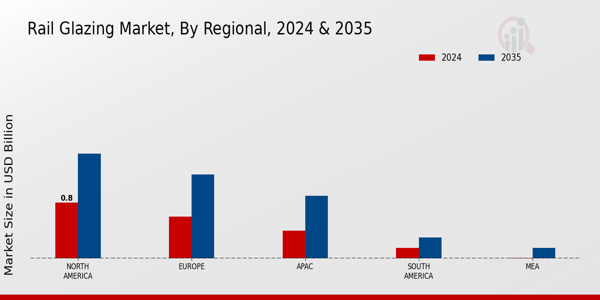Market Growth Projections
The Global Rail Glazing Market Industry is poised for substantial growth, with projections indicating a market value of 2.01 USD Billion in 2024 and an anticipated increase to 3.8 USD Billion by 2035. This growth trajectory suggests a compound annual growth rate of 5.96% from 2025 to 2035, reflecting the industry's resilience and adaptability to changing market dynamics. Factors such as technological advancements, regulatory influences, and infrastructure investments are likely to contribute to this upward trend. The market's expansion is indicative of the increasing importance of rail transport in global mobility solutions.
Expansion of High-Speed Rail Networks
The expansion of high-speed rail networks is a significant factor propelling the Global Rail Glazing Market Industry. Countries are increasingly investing in high-speed rail systems to improve transportation efficiency and reduce travel times. These systems require specialized glazing solutions that can withstand high speeds and varying weather conditions. As nations prioritize the development of high-speed rail infrastructure, the demand for advanced glazing technologies is likely to increase. This trend not only supports the growth of the rail glazing market but also aligns with broader transportation goals aimed at enhancing connectivity and sustainability.
Increasing Demand for Passenger Safety
The Global Rail Glazing Market Industry is experiencing a notable surge in demand for enhanced passenger safety features. This trend is largely driven by regulatory frameworks that prioritize safety in rail transport. For instance, the implementation of stringent safety standards necessitates the use of advanced glazing materials that can withstand impacts and provide better visibility. As a result, manufacturers are increasingly investing in high-performance glazing solutions. This shift is projected to contribute to the market's growth, with the industry expected to reach 2.01 USD Billion in 2024, reflecting a growing emphasis on safety in rail systems globally.
Urbanization and Infrastructure Development
Rapid urbanization and infrastructure development are key drivers of the Global Rail Glazing Market Industry. As cities expand, the demand for efficient public transportation systems, including rail networks, is increasing. Governments worldwide are investing in rail infrastructure to accommodate growing populations and reduce traffic congestion. This trend is evident in various countries, where new rail projects are being initiated to enhance connectivity. Consequently, the demand for high-quality rail glazing solutions is expected to rise, supporting the industry's growth trajectory. The anticipated compound annual growth rate of 5.96% from 2025 to 2035 underscores the potential for expansion in this sector.
Technological Advancements in Glazing Materials
Technological innovations in glazing materials are significantly influencing the Global Rail Glazing Market Industry. The introduction of lightweight, durable materials such as polycarbonate and laminated glass is enhancing the performance and efficiency of rail vehicles. These advancements not only improve energy efficiency but also reduce maintenance costs associated with traditional glazing solutions. The ongoing research and development efforts in material science are likely to propel the market forward, as manufacturers adopt these cutting-edge materials to meet evolving industry standards. This technological evolution is expected to play a crucial role in achieving a projected market value of 3.8 USD Billion by 2035.
Environmental Regulations and Sustainability Initiatives
The Global Rail Glazing Market Industry is increasingly influenced by environmental regulations and sustainability initiatives. Governments are implementing policies aimed at reducing carbon emissions and promoting eco-friendly materials in transportation. This has led to a growing preference for glazing solutions that are not only energy-efficient but also recyclable. Manufacturers are responding by developing products that align with these sustainability goals, thereby enhancing their market competitiveness. As the industry adapts to these regulations, the demand for sustainable glazing options is expected to rise, further driving market growth in the coming years.




















Leave a Comment